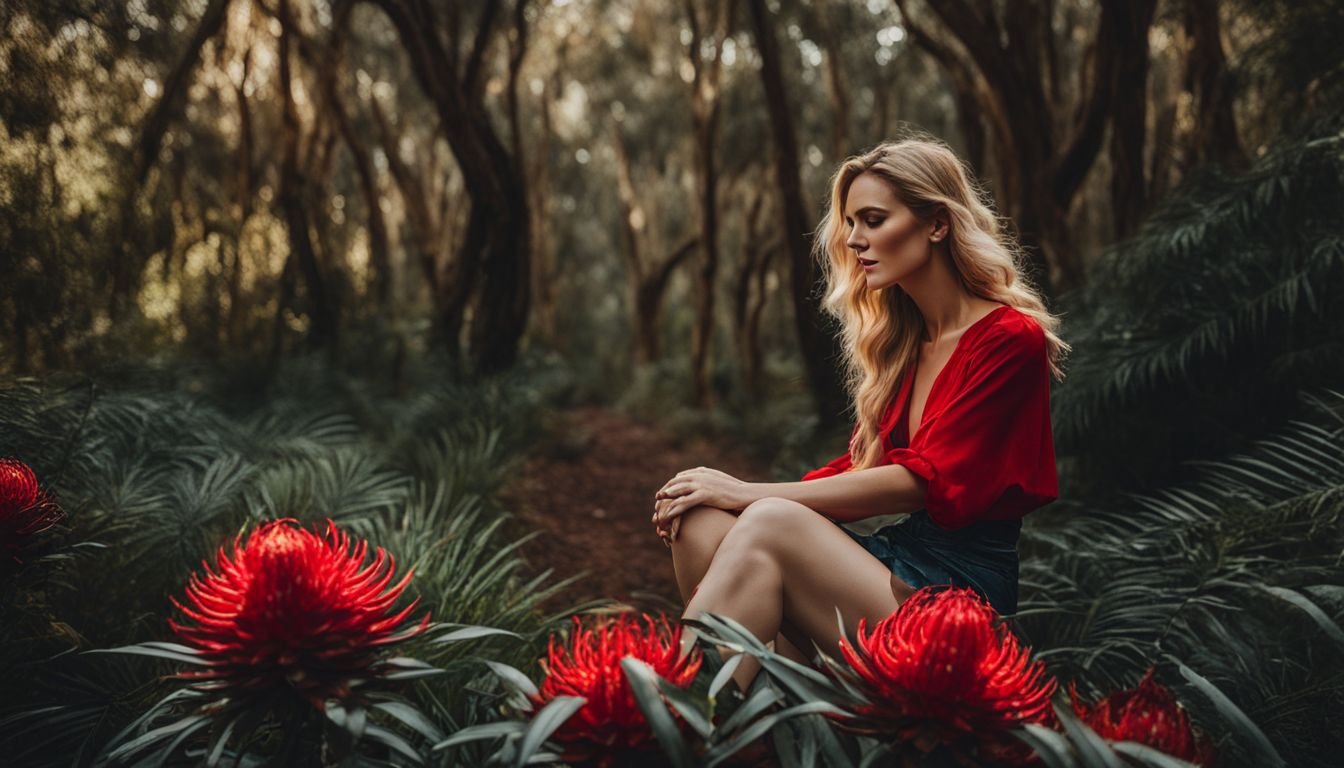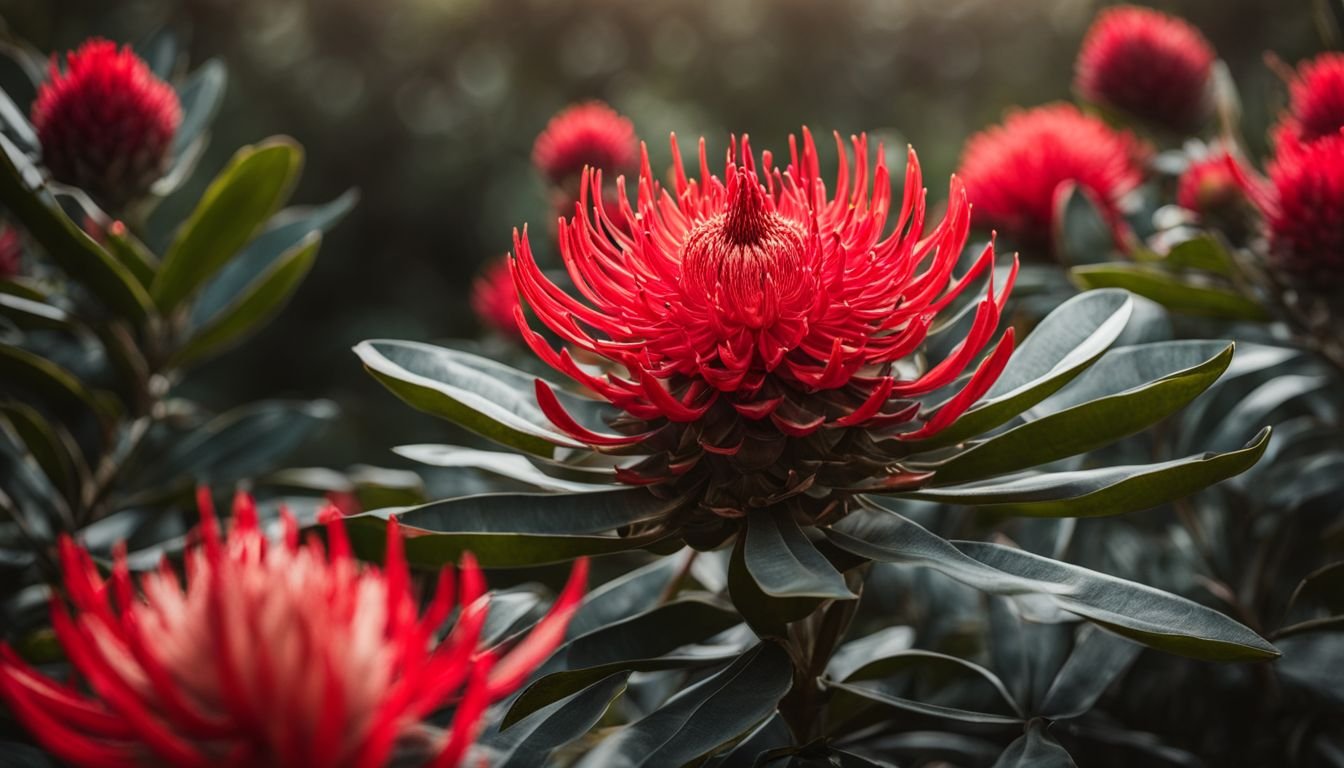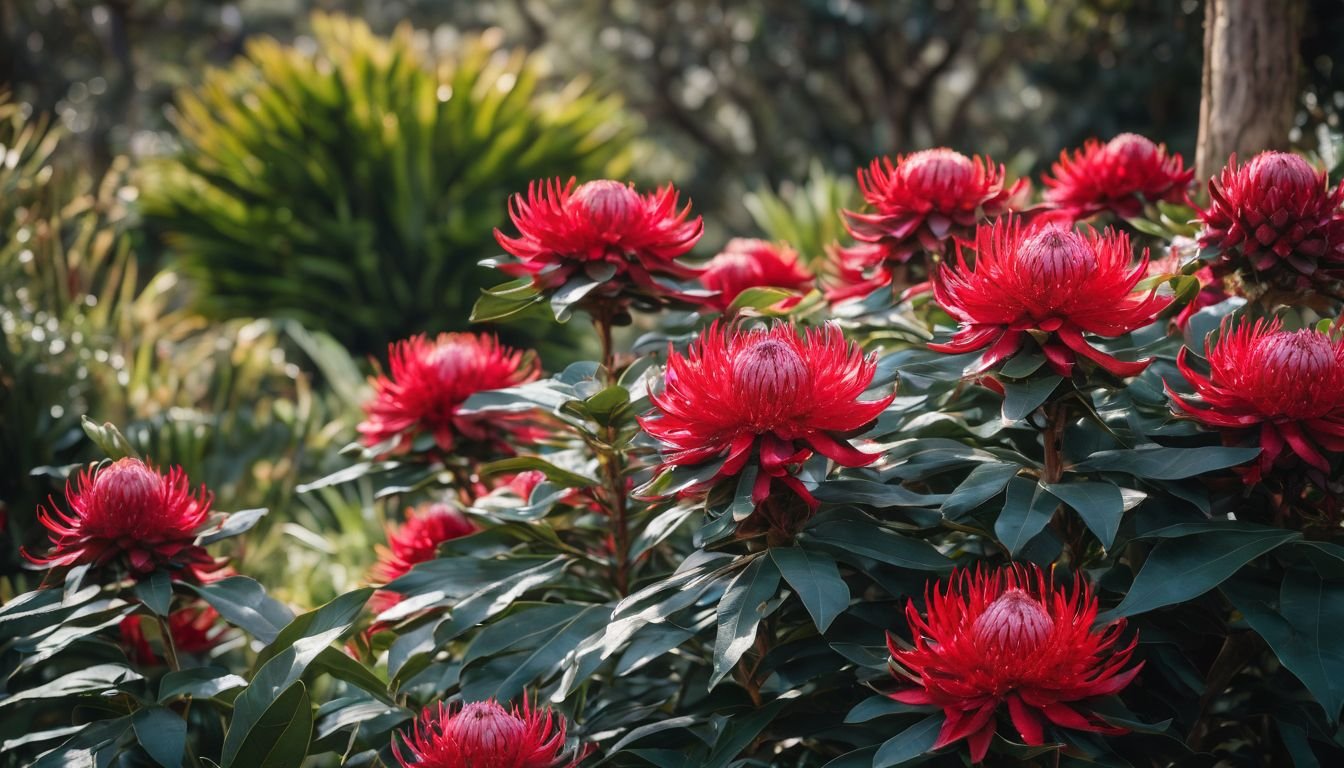Gardening enthusiasts often struggle to find a plant that provides stunning blooms and is also wildlife-friendly. The Red Waratah, with its vibrant flowers and bird-attracting qualities, stands out as an Australian native gem.
This guide will unveil the secrets to successfully growing and caring for this enchanting flower, ensuring your garden becomes a spectacular showcase of color and life. Dive in for a blooming transformation!
Key Takeaways
- The Red Waratah is a resilient native Australian flower, perfect for attracting birds and adding striking colour to gardens.
- It requires full sun to semi-shade, well-drained acidic soil, and moderate watering to thrive; protection from strong winds and frost is also important.
- Pruning after flowering encourages new growth, while using the right fertilisers in spring helps produce vibrant blooms.
- Pairing with complementary plants like lavenders or flame trees creates beautiful garden landscapes that support biodiversity.
- Regular maintenance including proper pruning, monitoring water levels, and pest control keeps the Red Waratah healthy year-round.
The Enchanting Beauty of the Red Waratah

Dive into the captivating allure of the Red Waratah, Australia’s illustrious native bloom that stands as a symbol of beauty and resilience in diverse landscapes. This striking flower not only mesmerises with its bold crimson hues but also carries deep cultural significance, making it a cherished addition to any garden or natural setting.
Overview of the Waratah plant
The Waratah plant, with its scientific name Telopea speciosissima, is an emblem of natural resilience and beauty along the East Coast of Australia. This hardy hybrid stands tall in harsh conditions, proudly displaying its vibrant red blooms during the spring season.
Reaching up to 3 metres in height and spreading about 1.5 metres wide, it’s a true spectacle in any garden.
Cultivating this native wonder requires full sun to semi-shade locations and well-drained acidic soils where they flourish best. Gardeners favour the Waratah for its moderate water needs and striking presence that not only adds aesthetic value but also invites a symphony of birdlife into the garden space.
It holds up well against moderate frost, making it versatile across different landscapes while adding significant value as a screening plant or potted marvel when using Native potting mix enriched with low pH fertilisers specially formulated for these robust perennials.
Significance of the Red Waratah in Australia
More than just a stunning plant, the Red Waratah holds deep cultural and symbolic value in Australia. It stands as the state emblem of New South Wales, embodying Australian strength, beauty, and resilience.
To the Indigenous people of this land, it carries significance tied to their long-standing traditions and connection with nature.
This vibrant bloom not only enhances garden aesthetics but also supports critical biodiversity by attracting local birds and insects vital for ecological balance. Its role extends beyond natural beauty; artists and poets draw inspiration from its striking presence, influencing creative expressions that shape Australia’s cultural identity.
Australian efforts are focused on conserving Waratahs so future generations can continue to enjoy their majestic allure amid native flora.
Caring for such an important flower comes with its own set of challenges and rewards – moving on to understanding the characteristics of the Red Waratah is key to successful cultivation.
Characteristics of the Red Waratah

The Red Waratah, with its striking and intricate floral display, embodies a charm that’s deeply rooted in the Australian landscape. Upon delving into its characteristics, one is greeted by a mesmerising structure that is as complex as it is beautiful, setting the stage for an exploration of this native wonder.
Description of the flower structure
Waratah flowers showcase a remarkable structure with their large, vibrant red heads standing out against grey-green leaves. Each head is a composite of many small flowers, packed closely together to form what appears as one single spectacular bloom.
These showy heads contain numerous individual flowers, sometimes up to 240, each including its own perianth and reproductive organs—the pistil and stamens.
Garden enthusiasts often marvel at the flower’s unique features: the long styles that shoot out from the centre like fireworks; the rich colour of every petal; and how they attract various pollinators to their nectar-rich blooms.
Waratah blossoms are not just visually stunning but also structurally fascinating, with each aspect playing an essential role in reproduction while adding aesthetic appeal to any garden landscape.
The unique colour and appearance
The Red Waratah stands out with its mesmerising crimson hue, captivating onlookers and bringing a lively splash of colour to any garden. Its flat flower head radiates against the green backdrop of foliage, turning heads during its bloom in the spring season.
Attracting native birds and insects, this iconic bloom forms a natural spectacle that’s both breathtaking and beneficial for local biodiversity.
Crafted by nature to catch every eye, the plant’s fiery shade isn’t just beautiful; it symbolises endurance in harsh landscapes. Such an alluring feature makes it an exceptional choice as a focal point in landscaping designs.
Garden enthusiasts often use it as a standalone marvel or pair it with contrasting plants to create visually striking effects that celebrate Australia’s rich botanical heritage.
Growing the Red Waratah
Discover the secrets to nurturing Australia’s iconic Red Waratah, as we delve into the specific conditions that allow this striking native to thrive. With expert guidance, embark on a journey to transform your garden with the resplendent blooms of Telopea speciosissima.
Ideal conditions for growth
The Red Waratah, known scientifically as Telopea speciosissima, flourishes in specific environments. To see the iconic red blossoms brighten your garden, consider these growth conditions:
- Choose a sunny to semi – shaded spot as the Waratah enjoys both full sun and dappled light. This ensures that it gets enough sunlight for healthy flower production.
- Develop acidic, well – drained soil with a low pH balance to mimic Waratah’s natural habitat. It allows for proper root development and nutrient uptake.
- Ensure moderate watering schedules, as Waratahs prefer soil that is moist but not waterlogged. Overwatering can lead to root rot and other issues.
- Provide protection from strong winds which can damage the large flowers and sturdy stems of the plant.
- Consider potting for control over soil quality if your garden doesn’t naturally meet these conditions. Use Native potting mix augmented with suitable fertilisers for optimal plant health.
- Be mindful of frost exposure; while Waratahs tolerate moderate frost, it’s wise to shelter younger plants during especially cold snaps.
Tips for planting
- Choose a sunny to semi-shady spot in your garden where the soil is well-drained and acidic; this echoes their natural habitat.
- Test the soil’s pH level; Red Waratahs prefer it low, mimicking nutrient – poor soils they’re accustomed to.
- Incorporate organic matter to improve drainage, especially if your garden has heavy soil. This prevents waterlogged roots which can be detrimental to the plant.
- Use containers with proper drainage holes if planting in pots, ensuring excess water can escape.
- Fill pots with a high – quality Native potting mix that caters specifically to Australian native plants like Telopea speciosissima.
- Water moderately after planting. Overwatering can lead to fungal infections, while under – watering stresses the plant.
- Apply a native plant fertiliser sparingly; these plants are used to leached nutrients and will flourish with just the right amount of feed.
- Protect young plants from moderate frosts by providing shelter or using frost cloths as they establish themselves.
- Consider using biological control methods instead of pesticides, protecting the surrounding ecosystem and aquatic life if near waters or ponds.
- Propagate from cuttings or purchase seedlings from reputable nurseries that specialise in native species cultivation.
Caring for the Red Waratah
Ensuring the vibrant health and blossoming of your Red Waratah requires attentive care and specific nurturing practices. Discover the essentials in watering, feeding, and maintaining these spectacular Australian natives to keep them thriving in your garden.
Watering and feeding requirements
- Provide moderate watering for the Red Waratah, as it is crucial to avoid over – saturation which can lead to root rot.
- Aim for well – drained acidic soil with a low pH to mimic the Waratah’s natural growing conditions.
- During dry spells, increase watering frequency but always allow the soil to dry out slightly between waterings.
- Employ mulch around the base of your Waratah to maintain moisture levels and regulate soil temperature.
- Use Native potting mix when planting in containers; it promotes better drainage and mimics the flower’s natural habitat.
- Spring is feeding time for Telopea ‘Shady Lady Red’, so administer a good quality native fertiliser to encourage lush growth and bountiful blooms.
- Keep feedings light; excess nutrients can harm more than help, leading to leaf burn or weak flowering.
- Observe the foliage for signs of nutritional deficiencies or overfeeding, adjusting your approach accordingly.
Pruning and maintenance
Pruning and maintaining your Red Waratah is essential for its thriving beauty. It encourages the plant to produce vibrant blooms and supports its overall health.
- Start pruning after the flowering season has ended. This helps the plant conserve energy for new growth.
- Use sharp, clean gardening shears to make precise cuts. Clean equipment prevents the spread of disease.
- Cut back any dead or diseased wood to maintain a healthy plant structure and appearance.
- Aim to shape your waratah into a compact bush, which allows sunlight to reach all parts of the plant.
- Regular pruning ensures that nutrients are not wasted on woody, non – productive stems.
- Pick off all spent flowers from the Red Waratah. Doing so stimulates the production of more blooms.
- Remove any weak or spindly branches that can detract from vigorous growth.
- Ensure you make cuts just above leaf nodes or buds facing towards the outside of the canopy. This directs new growth outward and keeps the interior open for air circulation.
- Spring is an ideal time for feeding with quality native fertilisers that promote lush foliage and spectacular flowers.
- Check for signs of pests like leafminers. Take immediate steps to control these invaders as part of routine maintenance.
The Red Waratah in the Garden
The Red Waratah’s fiery blooms act not only as a stunning focal point in Australian gardens, but also enhance the beauty and biodiversity of outdoor spaces. Incorporating this native treasure into your landscape promises to bring both aesthetic pleasure and a touch of national pride to your personal oasis.
Landscaping uses
With its vibrant blooms and dense foliage, the Telopea ‘Shady Lady Red’ – Waratah serves as a stunning windbreak in your garden. It stands firm against gusts while adding an element of natural beauty that effortlessly blends with other plants.
As a hybrid, this waratah has been crafted to endure moderate frost, making it resilient enough for various climates and perfect for Australian gardens seeking year-round interest.
Incorporating the red waratah into your garden attracts local birdlife, adding an extra layer of life to your outdoor sanctuary. Its reputation as a superb screening plant means you can enjoy both privacy and aesthetics.
Place these eye-catching shrubs where they can be admired; their rich colour is sure to be the focal point of any landscape design. The dense medium to large size also makes them ideal for creating structured yet enchanting backdrops for flower beds or alongside pathways.
Complementary plants
Transitioning from the landscaped beauty that Red Waratahs can bring to your garden, consider introducing complementary plants that enhance this visual splendour. The Telopea ‘Shady Lady Red’ is a perfect match for the fiery Waratah, thriving under similar conditions and creating harmonious displays in both garden beds and larger containers.
Plant them together to achieve a stunning contrast of textures and an array of vibrant reds throughout your outdoor space.
Selecting companions for your Red Waratahs involves understanding plant relationships and shared preferences for sunlight, soil type, and watering needs. Lavenders are excellent partners, offering fragrant foliage alongside the bold Waratah blooms while also attracting beneficial pollinators into your garden ecosystem.
Embothrium or Flame Trees complement with their striking orange candles when planted nearby, echoing the theme of bold colours and robust forms characteristic of Australian native flora.
These combinations not only add dimension to gardens but work together cohesively, promoting healthier growth by sharing mutual benefits such as shade tolerance or water requirements without competing aggressively for resources.
Conclusion
Embrace the striking presence of the Red Waratah in your garden for a spectacular display that’s truly Australian. With its robust growth and vibrant blooms, it becomes more than just a plant—it’s a centerpiece that invites local wildlife into your backyard haven.
Follow these guidelines to grow and nurture this magnificent species, ensuring it flourishes year after year. Let every spring bring about an awe-inspiring spectacle with the Telopea ‘Shady Lady Red.’ Lean on these tips to transform gardening endeavors into a canvas painted with nature’s most vivid hues.
Discover the perfect companion for your enchanting Red Waratah with our guide on growing Chinese Star Jasmine, another stunning addition to your Australian garden.
FAQs
1. What makes the Red Waratah special in Australia’s flora?
The Red Waratah, or Telopea speciosissima, is prized for its stunning terminal flowers and vibrant colour, making it a standout among Australia’s native plants.
2. Can I grow a Red Waratah in my garden if there are frost conditions?
Yes, with moderate frost tolerance, the ‘Waratah Shady Lady Red’ cultivar can thrive in cooler climates whilst adding spectacular beauty to your garden.
3. How do you successfully propagate the Red Waratah?
To propagate the Red Waratah effectively, grafting techniques using a sturdy rootstock from species like T. mongaensis or T. truncata often ensure healthier growth and blooms.
4. Is it possible to improve the germination rate of Red Waratah seeds?
Absolutely! By mimicking their natural environment which includes exposure to smoke that stimulates seed germination – known as pyrogenic flowering – you can boost your germination success rates for these iconic flowers.
5. What type of care does a planted Red Waratah need to thrive?
A well-planted waratah requires consistent weed control, proper water management—especially avoiding low oxygen situations—and protection against fruit-eating pests to flourish season after season.
6. Are there different types of waratahs I can plant alongside the common New South Wales variety?
Indeed there are; Telopea speciosissima x oreades is just one example of several species and hybrids available for diversifying your ornamental garden with this magnificent Australian native flower.
